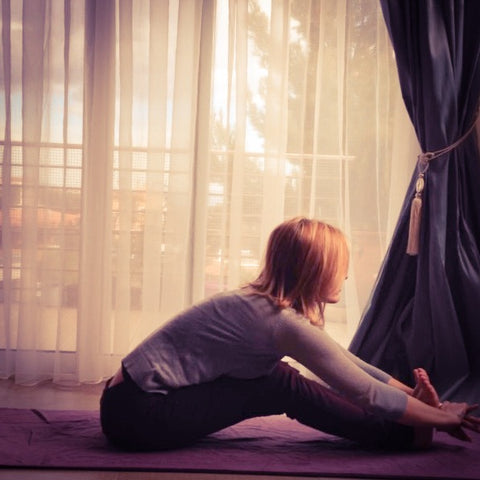Seated Forward Bend: Find the best Paschimottanasana for you

The seated forward bend which is a bit of a mouthful in Sanskrit (Paschimottanasana) is a beloved yoga pose. It is a pleasure to do once you find your version of the posture (with the help of this article), no matter how flexible or inflexible you feel. To some who are endowed with flexibility, this is a posture where you may be tempted to just hang out and pretend to be working out. This would be where the yoga teacher will slap your wrist and tell you that that would be defeating the object, and they'd be right. This pose has so much to offer if we learn to do it right. So if you want to do a proper yoga seated forward bend (no cheating) check out this short and sweet but extremely thorough video by Kino MacGregor.
In summary:
- Come into a seated position with the legs straight out in front of you, the big toes touching and the sitting bones planted firmly on the mat.
- Engage the pelvic floor to pick the spine up so you can pivot at the hip joints not letting the pelvis tilt under.
- The first thing you want to make contact with the thighs is the chest not the belly, so make sure that you keep the belly nice and tightly drawn in the whole time.
- Reach forward, hold on to the big toes, roll the shoulder blades back and reach the spine away from the waist.
- Suck the belly towards the spine, lift the chest away from the waist, pivot at the hip joint and exhale, fold forward, either placing the head down (if you are flexible enough to be able to go all the way down) or gaze forward at the toes.
- Be careful not to do the work with your arms by puling on the toes; do the work from deep within.
Now that you've got the technique down (thanks to Kino) we're sure that you have a lot of other questions (at least 10 to be exact). So we're going to tell you everything you need to know about Paschimottanasana in the form of 10 FAQs.
1. What does the Sanskrit word Paschimottanasana mean and how do I pronounce it?
Paschimottanasana is not literally translated as 'seated forward bend' as you would think.The name comes from the Sanskrit words paschima meaning "west" or "back" or "back of body", and uttana meaning "intense stretch" or "straight" or "extended". - Wikipedia
Got that? Here's a great article for more about the meaning behind the name. Now for the pronunciation. Here goes. Pash-Ee-Mow-Tan-Ass-A-Na.
2. Great. Now that's out of the way, what good is a Pash-Ee-Mow-Tan-Ass-A-Na?
It's a superb stretch for the hamstrings and the spine, as well as lengthening the spine. It's also a posture which works on the internet organs. It massages and wakes them up and is known to help with digestive problems. It's also one of the more calming and relaxing poses.
3. What am I supposed to be feeling in this pose?
You should feel the spine lengthening and stretching and a definite healthy pull of the hamstrings. Oh, and inner calm and serenity. :)
4. Why can this baby do it and I can't?

Because babies are super bendy, little aliens. You most probably have tight hamstrings but the great news is that's what this pose is actually for: getting the hamstrings nice and loose and as flexible as this baby. Well, nearly.
5. I'm having difficulty. Help!
Never fear, Lots of Yoga is here and we have so many lovely modifications for you!
(a) Bend the knees
A simple solution is to bend the knees, like our little friend here. This releases the pressure on the hamstrings.

You can get an awesome Paschimottanasana with the belly touching the thighs as it's meant to be if you bend the knees, keeping a nice straight spine and with each breath perhaps you'll be able to feel the hamstrings lengthening ever so slightly.

(b) Pop something under your bum
We found that having a small block, bolster, rolled up mat or blankets under the sacrum is really helpful on those particularly rigid days.
(c) Enlist a friend's help
In a class, a teacher or a friend can push your lower back forward, to help you get a deeper stretch. Or you can find a child and get them to stand on you. They'll love that. Not too sure about you though.

The Iyengar way
The man was a genius. Look at these lovely forward folds done with props which look and feel super comfy.
6. How low should I go?
As far as you can go without arching the back. If you manage to get all the way down, bravo! Otherwise, as you're leaning forward towards your toes, as soon as you feel your hamstrings start to constrict, that is a good place to stop. Make sure the spine is nice and long, and start counting your breaths.
Otherwise, as you're leaning forward towards your toes, as soon as you feel your hamstrings start to constrict, that is a good place to stop. Make sure the spine is nice and long, and start counting your breaths. 
7. Where are my hands supposed to be?
One hand grabs the other wrist at the soles of the feet. OK, you can stop panicking now because there are many other options! Like for instance, grabbing your toes, the Ashtangi way.
OK, you can stop panicking now because there are many other options! Like for instance, grabbing your toes, the Ashtangi way.  Placing your hands on or beside your shins or knees. If you have big boobs (give some to us, please) you can open the legs slightly to accommodate your God-given assets.
Placing your hands on or beside your shins or knees. If you have big boobs (give some to us, please) you can open the legs slightly to accommodate your God-given assets.  Or you can use a trusty strap.
Or you can use a trusty strap. 
8. Is the back supposed to be arched or straight?
The back is supposed to be as straight as possible. You may see some people being able to get their face down to their knees in this pose but their back is arched like a rainbow. This pose is not a bending of the back or spine, it is bending at the waist. If you have a nice straight back but your head is nowhere near your legs, you are still getting more benefits than if you were to arch your back to reach your head all the way down to your knees. This video has little nice trick to keep the alignment of the back straight and not arched.
You may see some people being able to get their face down to their knees in this pose but their back is arched like a rainbow. This pose is not a bending of the back or spine, it is bending at the waist. If you have a nice straight back but your head is nowhere near your legs, you are still getting more benefits than if you were to arch your back to reach your head all the way down to your knees. This video has little nice trick to keep the alignment of the back straight and not arched.
9. What else can Paschimottanasana be used for?
It can be used to counteract any back-bending. When you've done a bridge or any other back bends, the best way to relax your spine and back is to go straight into a modified Paschimotanasana with relaxed bent knees, and you can even rest your head on your knees and close your eyes. Ahh, heaven.
Ahh, heaven.
10. Weird thing you may hear from your yoga teacher for this pose?
"Open up the buttocks." What the teacher means is for you to move the flesh of the bum away from the sit bones so that you have a better seating surface and foundation for the posture. Yes, basically, open up your buttocks. Do you have any other tips, tricks, comments, questions about this pose? Get in touch and let us know!Follow us for more free, high-quality yoga and mindfulness content... and subscribe to our mailing list below!
*indicates required field
Also in Yoga Poses



